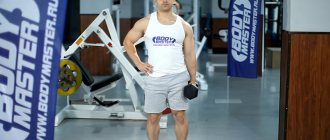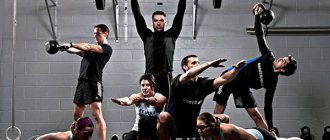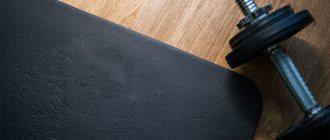Are books for bodybuilding necessary today, in the age of digital technology? At first glance, it may seem that no, but if you discard the gigabytes of unnecessary and even unreliable information that is “driven” to the masses, purchasing books about “iron sports” no longer seems like such a worthless idea. The literature that was published twenty and even ten years ago in paper format, the vast majority of them, were written by professionals, experienced coaches, athletes and people who even have a scientific degree in medicine and high achievements in sports. It is the best books on bodybuilding that will be discussed in this article.
1. “The New Encyclopedia of Bodybuilding.” Schwarzenegger Arnold, Bill Dobbins
This is a complete ABC for a beginner and even an advanced athlete. It was written directly from the mouth of “Iron Arnie” himself. The book has a lot of illustrations, valuable experience of an outstanding athlete and contains information from motivation and history to practical advice. It contains training methods, exercises, nutrition systems. You can also find information about posing for competitions, cutting and bulking. This book is a bodybuilder's almanac.
Rational nutrition for athletes. P.I. Pshendin
The right approach to nutrition makes 50% eat and in what quantities to dry muscles, gain muscle mass or lose weight .
Rational nutrition for athletes. P.I. Pshendin
The author of the book, one of the best specialists in Russia on the physiology and biochemistry of athlete nutrition, Candidate of Biological Sciences, examined the nutrition of athletes from a scientific point of view, bringing clarity to the understanding of drawing up the correct menu during the competitive and post-competitive period training .
The book is very valuable; it reveals all the subtleties and secrets of a balanced, rational and healthy diet for athletes. With it, you will learn how to create an individual diet based on your energy needs, material capabilities and, of course, your type of sport , and this information about adequate nutrition will be useful not only for amateurs, but also for professionals .
Of course, all sections of the book will be difficult, even simply impossible, to master the first time, therefore, choose to study the section that is most important for you (for example, energy metabolism during physical work, training regimen and nutrition regimen depending on the type of sport, rational nutrition in bodybuilding and so on)
Downloaded: 6003, size: 544.7 KB, date: April 18. 2018
"A complete bodybuilding course from beginners to professionals." I. E. Gusev
The book will help a novice athlete choose a training regimen and choose optimal nutrition. The book, in essence, is a training manual for those people who have not played sports and are just planning to start. For experienced athletes, this literature will not be relevant.
And also read: Mike Mentzer's Supertraining - program and essence → Films about bodybuilding: top 10 → 8 strong books about sports →
Powerlifting. The path to strength. V.L. Muravyov
A book that will help you build strength and understand how to build your training program to increase strength.
Powerlifting. The path to strength. V.L. Muravyov
Despite the fact that training is considered in this book not from the side of bodybuilding, but from the side of powerlifting , it still deserves close attention. After all, we all know that the best exercises for muscle growth are basic ones , especially when it comes to a beginner level athlete.
to build large muscle mass without strength training. To make muscles grow, you need to perform basic exercises first (deadlift, squats, bench press), in this book, everything is written about them in detail and illustrated , tips, recommendations and training plans are given to increase strength in basic exercises.
The author of the book is a world and European record holder in powerlifting.
Downloads: 3882, size: 70.2 KB, date: April 18. 2018
Training diary
To monitor your own progress and timely adjust the program if the need arises, the first thing any novice bodybuilder should do is keep a training diary. The following items should be written down in your personal notebook:
- results;
- workout;
- outlines of training programs.
Thanks to the diary, the athlete has the opportunity to monitor his progress and set new goals. In addition, achieving certain results recorded in a notebook is a motivating factor.
The concept of load progression
From the first lessons you cannot load yourself to the point of complete failure. Results should be improved gradually. Progressivity of loads varies. It involves either reducing the speed of performing an exercise or increasing the intensity of the training. Both options are more suitable for experienced athletes. For a beginner, it is better to focus on working weights, which are gradually increased. This approach is due to the fact that beginners cannot yet clearly sense the signals sent by the body.
Forced repetitions will only cause many mistakes and can cause a slowdown in progress. To prevent this, you should increase the working weights and master the technique, and not chase an increase in the number of approaches performed. This approach should be followed in the first year of training. After 12 months of intensive and regular training, it will be possible to focus on complicating the training program itself.
To learn to understand the signals that the body sends and listen to your own body, you should not immediately start with complex exercises. Experts recommend focusing on basic movements first. Honing your technique in basic exercises allows you to move on to more complex ones without any problems with correct execution.
Dr. Luber. Bodybuilding our way
As you know, everything ingenious is very often simple, and this book is no exception in this regard. This book is written in simple and understandable language , reveals all the “secrets” of the rocking chair of the 80s, 90s , in an accessible language conveys to the reader valuable knowledge about bodybuilding, how to train, eat, rest, what exercises are best to use in your training , when and who should use steroids, and much more.
Dr. Luber. Bodybuilding our way
In all its diversity, this book tells the reader that the process of building muscles is quite simple (subject to the training regime, diet and sleep), there are no magical exercises, techniques, machines, super-advanced gyms, on the contrary there are ordinary racks, a bench , parallel bars and a barbell, this is the equipment with the help of which the muscles of the bodybuilding champions of the last century were created. Listen to the advice and recommendations of this book, especially if you are just plunging into the world of bodybuilding .
The author of the book is Doctor
Luber
(Alexei Viktorovich Kireev), one of the best bodybuilding coaches in Russia, who has trained many Russian champions on numerous occasions; he also advised the rebel, modern bodybuilding star, Andrei Skoromny.
Downloads: 2983, size: 1.3 MB, date: 18 Apr. 2018
Mike Mentzer. Super training
The book is a masterpiece , you won’t read anything like this in any manual or textbook on bodybuilding, the author brilliantly combined bodybuilding and philosophy .
Mike Mentzer. Super training
Mike's revelations will not only become a powerful motivator to continue training , but will also answer such philosophical questions as why we came into this world, who we are, where we come from, in general, why all this, why do we constantly exhaust ourselves with heavy loads in gym, why a person should develop, and so on.
After all, there are moments in life when it becomes hard for the soul , moments of despair and depression overcome everything, and you want to give up everything, quit training with iron . So, so that you have fewer such deplorable periods, so that you are always motivated for results, so that you have the desire to develop physical and spiritual strength, and also understand and understand bodybuilding from the inside, we definitely recommend reading this book.
Author of the book, multiple champion of the most prestigious bodybuilding competitions, silver medalist of the 1979 .
Downloads: 3960, size: 111.4 KB, date: April 18. 2018
Anatomy of strength training for men and women. Delavier Frederic
This book, with its content, shocked the entire sports world ; people have never seen such colorful, illustrated material performed by athletes in various bodybuilding exercises .
This is a book, a unique base of exercises that, in principle, exist in bodybuilding.
Anatomy of strength training for men and women. Delavier Frederic
The book by Delavier Frederic will tell you not only about all the exercises that exist in bodybuilding, but also show their technique from an anatomical point of view, illustrated pages will help you understand which muscle work in certain exercises.
If you are striving to study bodybuilding, so to speak, from the inside, then this is the book for you, because in order to pump up muscles, you need not only to know how to lift iron, but also to understand what muscle groups are called, what they are attached to, what exercises make you grow , certain muscle groups.
The book is universal , suitable for a wide range of readers, from amateurs and fitness instructors to medical students .
The author of the book is, in one person, a successful weightlifter, medical scientist, editor of popular magazines in Europe, and a brilliant artist.
Downloaded: 5827, size: 70.1 MB, date: April 18. 2018
Trading fat for willpower
Author: Yaroslav Brin
A simple, accessible book, which is a collection of articles about basic and step-by-step weight loss.
The motto of Brin’s manual is “No to complexes, excess weight and discomfort!” Here you will find a clear action plan for every day for quick and irreversible fat burning.
In a very unique (sometimes cynical, “uncut”) form, the author gives recommendations not only for combating the hated extra pounds, but also for changing one’s worldview in a positive direction.
J. Vader. Body building system
The book that is in front of you is one of the most detailed and complete manuals on bodybuilding in general ever published. The author tried to bring all his accumulated experience , collected a lot of training programs on bodybuilding, and provided a huge amount of advice for beginners, ranging from how to train to preparing for competitions .
J. Vader. Body building system
The book is not unambiguous, on the one hand there is a lot of everything, even too much, on the other hand there is too much variety in exercises , a large number of repetitions, approaches, and exercises in one training day , can affect your recovery , so “filter” everything , what is written there, emphasize for yourself something new, take on board Vader’s .
Perhaps the author was mistaken in some way, but she definitely deserves attention in her bodybuilding training.
The author of the book is Joe Weider, a Canadian bodybuilding coach, founder of the Mr. Olympia competition, and the international bodybuilding federation IFBB .
Downloaded: 3839, size: 2.2 MB, date: April 18. 2018
Magic morning. How starting your day can change your whole life
Book in the online store
The easiest way to transform your life is to take control of your morning. Just one hour before breakfast can help you lose weight, tone up your abs, write a book, or learn a foreign language. In The Magic Morning, personal productivity and time management expert Laura Vanderkam analyzed the daily routines of many successful people and wrote a book detailing which habits help them achieve success. This book is for those who:
— the alarm clock endlessly sets for “another five minutes”;
- cannot find time for really important things;
- I would like to do more and better;
— seeks balance between work and personal life.
FOODBALL
Book in the online store
Continuing the theme of the championship, we’ll tell you about another new product. While the Russian national team was preparing to win, chefs in restaurants in eleven football capitals were training to shine with traditional Russian hospitality. After all, it depended on them how foreign fans remembered Russian cuisine.
A team of professional chefs has collected the most spectacular recipes from all over the country in a unique collection: “FOODball. A culinary journey through 11 football capitals of Russia."
So what do foreigners talk about at home, remembering Russian pickles with nostalgia? What should future guests of our country try?
In Moscow, of course, there is borscht and pancakes with caviar. And for breakfast - cheesecakes. In St. Petersburg - beef stroganoff and fried smelt. In the morning you can have crumpets. In Volgograd you need to appreciate watermelon honey and pike perch in batter. In Sochi, an indispensable item on the program is lamb shish kebab and chebureki. In Kazan there is a place to go gastronomically, starting with echpochmaks. In Yekaterinburg, the main culinary event may be “Oil” dumplings with dill mousse and dumplings with baked potatoes and Carbonara sauce.
So, are you ready to jump on the train and go on a culinary journey? Make it happen with us!
Another you
Ten Velikhan currently runs the World Class Almaty club. He is a former Asian powerlifting champion (WPC federation). He has the title of Master of Sports in Bench Press (bench press).
The language of presentation is simple and clear, the volume of descriptions is quite sufficient for beginners. In this “ABC” of fitness you will find the postulates of correct eating behavior with a specific “storyboard” of the weekly menu. The training cycle is scheduled for 12 months and includes 2 programs - for the gym and for the home. At the end there is popular information about the necessary vitamins, sports supplements and calorie content of foods.
Athletic tuning. A New Look at the Culture of Physical Excellence
Author - Soslan Varziev
The author’s name has been passed on “from mouth to mouth” for quite a long time through “word of mouth”. An authoritative specialist in the field of personal training did not “shine” in public, which did not prevent such famous people as Rupert Everett, Yarmolnik and Dolina, etc. from turning to him for help.
The book outlines Varziev’s unique methodology, presented in the form of an excursion into the world of physical culture with lyrical digressions and good humor.
Text of the book “Bodybuilding, athleticism for everyone”
V. D. Chingisov Bodybuilding, athleticism for everyone
Preface
This book is intended for those who want to improve their body, build muscles, improve their health, and, perhaps, become a professional athlete in such an exciting sport as bodybuilding.
Currently, bodybuilding is becoming increasingly popular. Evidence of this is the ever-increasing number of gyms. Why does this “relative” of weightlifting attract its fans? First of all, due to its accessibility and the absence of an age barrier. It is also important that an athletic physique in the modern world is considered not only beautiful, but also fashionable.
Bodybuilding is not just about training with heavy loads. The goal of this sport is maximum muscle growth. Using various techniques, athletic gymnastics complexes, and weight training, you can achieve amazing results in building your own body.
Bodybuilders strive to increase the strength and size of their muscles. But why does this happen? You will learn about the structure of muscles and their function, the types of muscle fibers, and the correct ratio of the volumes of various muscles. The book will help you objectively determine the physiological specifics of the body, your body type. And this, to a large extent, especially at first, will dictate the strategy for practicing athletic gymnastics: the type of training, its intensity, the duration of the recovery period, diet, etc. Beginners will greatly benefit from advice and practical recommendations on how to increase sports loads, how to avoid mistakes and prevent injuries.
You will find here programs and systems of famous bodybuilding schools, the best training complexes - both for beginners and pros. And using special systems of targeted impact on individual muscle groups, you can achieve stunning results in building muscle mass. For more prepared athletes, a high-level bodybuilding program will be of interest.
Modern bodybuilding has its origins in weightlifting. This sport was born much earlier, and for a very long time its fundamental techniques and principles were accepted by bodybuilders as a basis. It was from weightlifting that the well-known postulate of progressive training stepped into bodybuilding: if you want to become stronger, lift heavier and heavier weights. For those who want to significantly increase muscle strength, here are the best training methods for training with barbells and kettlebells. By the way, this chapter will also be of interest to coaches and trained athletes.
In recent years, bodybuilding has been very popular among women, who have been characterized by beauty and plasticity since birth. Training programs designed specifically for the fair sex will help you form an ideal figure, correct physique flaws, and acquire unique grace of movement.
We can say that bodybuilding is not a sport, but an art. You, like a sculptor, day after day, from training to training, have an amazing opportunity to “sculpt” your body - beautiful, powerful, sculpted... And you need to approach this with complete dedication. After all, your body is the container and reflection of the soul. So the first thing you have to do is want to be strong. Mentally draw how you would like to see yourself, and without any doubt go towards your goal. And our book will help you with this. Good luck!
What is bodybuilding
Amateurs, having started bodybuilding, usually do not even try to achieve the success of the “stars”. It seems to them that professionals train using some secret methods. Of course, professionals have their own special techniques, which, without exaggeration, can be called the secrets of mastery. However, they are available to everyone. You may well become a champion by selflessly “swinging” somewhere in the province. Bodybuilding is not a sport where elite achievements are the lot of select individuals surrounded by a large staff of personal methodologists, doctors, pharmacologists, massage therapists and psychologists. All you need is to understand the methods of various systems and choose the best option for yourself.
Volume-strength training system
Let's start with the main thing: creating extreme muscle volumes is the task of a special training stage, which begins no earlier than after 2-3 years of hard training according to generally accepted initial schemes.
Neither entry-level training, nor even split training, interspersed with periods of specialization, will make you a giant like the Olympia winners. The strategic goal of all these complexes is one thing - to create a powerful psychophysiological foundation in your body that can withstand ultra-intense weight training.
Any attempt to start pumping up supermass before the body’s main physiological systems are ready for it can lead to the grave, not in the figurative, but in the literal sense of the word. Judge for yourself: if the specialization stage, when one muscle group is subjected to a shock load, should last no more than a month so as not to lead to overtraining during one or two years of bodybuilding, then in mass training you will have to “bomb” all the muscles with shock over the course of a year per year, i.e. decades! It is clear that such loads require unique qualities. And you can develop each of them in yourself.
If you start to think about the concept of intensity in bodybuilder training, it becomes clear that it is more of a mental in nature than a methodological term. In fact, passion, the desire to squeeze an inhuman maximum of tension out of the muscles at any cost, a strong volitional impulse at the moment of overcoming the weight - all these prerequisites for success in training for weight require a powerful psyche.
Just as no one is born with muscles capable of lifting enormous weights, no one is born with a strong psyche. The steel of the psyche, like the steel of muscles, is the result of training. At the same time, you need to remember the following: just as you cannot increase more than three kilograms of muscle mass per year, you cannot create powerful mental potential in yourself in a week. There can be a direct analogy here with developing a certain habit. As you know, this always takes a lot of time. True, in our case we are talking about a special kind of habit - to the enormous mental stress of training.
By methodically increasing the load, you, unnoticed by yourself, are pushing the boundaries of your own mental endurance. By the way, it is precisely this feature of bodybuilding - the development of global resistance to mental stress - that becomes the reason for the success of bodybuilders in entrepreneurship, study and mastering various difficult professions. The trained mind of a bodybuilder easily overcomes situations of nervous tension.
For mountain climbers, supersonic aircraft pilots and surgeons, the stress of risk becomes part of their existence over time. Without it, life seems meaningless to them. You can consider yourself ready for mass training only when you feel something similar in relation to regular athletic activity!
The problem of powerful ligaments is rarely covered in the literature on bodybuilding, yet it is key in the issue of increasing mass. The fact is that the use of heavy weight, especially by a bodybuilder who passionately wants to “grow,” often causes ligament injury. A volitional command causes the muscle to contract so strongly that the ligament attaching the muscle to the bone cannot withstand it and breaks.
If a bodybuilder gradually increases weight, then along with his muscles, his ligaments become stronger. They become thicker and their strength characteristics improve. Research shows that ligaments are truly strengthened only at the end of the third year of consistent bodybuilding.
Notice how difficult the bench press is for beginners. At first, they just can’t point the bar straight and lower it straight. After just a few lessons they are doing the movement correctly. What, your strength has increased? No, so-called motor coordination has improved. When we just begin to master some action, the brain sends an excessive number of impulses to the muscles, trying to insure ourselves in case of failure. Having received response impulses, it optimizes command signals: our actions become polished and error-free.
Any exercise in bodybuilding, no matter how simple it may seem, also needs to be learned, and here's why. By repeatedly doing the same movement, you form an optimal information channel through which the brain communicates with the muscle. As a result, you get excellent motor coordination when the brain controls the muscles using exclusively targeted nerve impulses. Obviously, improving motor coordination in practice means muscle growth: the more precise the nerve signal, the stronger the muscle contraction! The response impulses sent by the muscles to the brain also become more accurate. This explains the magical feeling of your body, familiar to every experienced bodybuilder.
Conclusions:
• First, you must understand that supermass is a goal within reach of anyone who has the ability to follow time-tested guidelines.
• Secondly, supermass requires a slow and measured approach. Do not hurry! Many people quit the race only because they get ligament injuries or exhaust themselves with excessive loads.
• Thirdly, pumping up supermass is largely a psychological process. Take on supermass pumping only when your psyche is calm.
You can't achieve super mass if you don't care about your nutrition. Weight does not grow at all if the daily energy intake is less than 4000 calories. Many champions eat five times a day and drink a protein drink every three hours, containing 1 g of protein for every 0.5 kg of body weight. Because muscle contraction is an electrical process. Electricity in this case is produced by intracellular biochemical batteries, which, like any other battery, need recharging and regular maintenance. Consign the energy component of your diet to oblivion, and you will receive the same response as when you turn off any electrical device from the outlet.
Stagnation is the peak of energy decline caused by a low-calorie diet. It is necessary to keep the energy value of the diet under strict control and plan tomorrow’s menu every evening with a calculator in hand. There is simply no other way.
The recovery factor in bodybuilding is something of a tip of the iceberg. Because it is not visible on the surface, its significance and scale are usually underestimated. Meanwhile, among amateurs, which is very significant, there are few for whom even a whole day of rest between workouts is enough. This explains the scattering of results: the traditional schedule of three daily workouts corresponds to the genetics of only rare individuals.
Today, almost everywhere in the world, professionals are training less. The anabolic effect, as it turns out, is determined not by quantity, but by quality. And this means not only a higher methodological level of training, but also the activation of recovery resources, which was not previously taken seriously.
One of the powerful methodological levers of recovery is conducting short, “hard” workouts, without changing the training schedule. Let's say you train four days in a row, resting every fifth day. If you reduce your workout time by using special intensity techniques to 1.5 hours instead of the usual 3 hours, you will add as much as 1.5 hours to the recovery period! Believe me, when combined with a change in intensity, those extra 90 minutes are amazingly effective!
Increase your weight in the off-season by no more than 4 kg. The fact is that simultaneously with weight gain, subcutaneous fat always increases. This is an interconnected process, and it is extremely difficult for a bodybuilder who has diligently increased his volume for a competition to get rid of the increased fat and gain good definition. There are no miracle cures for getting rid of subcutaneous fat. It is easy to fight it only in one case: if there is not enough of it. So don't complicate your path to victory by storing fat.
Bodybuilding is a type of anaerobic exercise, while running, swimming, playing sports, etc. train the aerobic qualities of the body. There, the focus is on the body’s ability to enrich the blood with oxygen and quickly deliver it to the muscles. This does not make the muscle bigger or stronger, but it significantly increases its endurance.
Much more powerful anaerobic energy mechanisms are involved in bodybuilding. They provide powerful explosive forces, which, however, are relatively short-lived. Compare: a single workout lasts no more than 2–3 hours.
These mechanisms operate practically without air oxygen, and therefore, during bodybuilding, the body’s aerobic abilities are not trained and do not grow. However, during training the body also works in aerobic mode!
By increasing the volume of loads, you increase the pressure not only on the muscles, but also on the aerobic mechanisms, which for you, as a bodybuilder, are in an undeveloped state! Oxygen metabolism deteriorates.
Since high tone and good mood depend on the oxygen saturation of the blood, sooner or later the state of the psyche becomes a crisis. Training stimuli cease to please, the desire to “pump up” disappears somewhere, i.e. the first signs of stagnation appear.
To prevent this from happening, do not train one-sidedly. Swim and run regularly. But remember, good things should be in moderation. Aerobic exercise should not go beyond mild pleasure. If you overdo aerobics, muscle volume will decrease, because during running, etc., the body produces energy by burning muscle protein molecules in an oxygen flame.
Strength training
An amazing paradox of bodybuilding: on the one hand, we are talking about the most powerful sport in existence, and on the other hand, physical strength does not guarantee any success on the competitive platform. All this creates confusion. Some “jocks” tear their veins for years, trying to set a record in the bench press or deadlift. Others focus on the biceps and do thousands of concentrated curls. Both look equally pale because they are equally wrong. So how should it be?
First, about methodological principles. Mass is given by high-repetition training (8-12 repetitions per set), strength – by low-repetition training (2-5 repetitions). No matter how fanatically you pump up your strength, you won’t gain much mass. Then why do you need strength training?! The secret is that these repetitions (for mass) must be done with a weight that matches the strength records. The real pumping of the pectoral muscles begins after you start bench pressing 130 kg. Methodists advise holding strength “sessions” twice a year. You can compose the complex yourself, guided by the methodological rules outlined below.
All attention to large muscle groups.
The strength of your muscles is determined by the strength of your large muscle groups - your back, legs and chest.
The main target of strength training is the largest muscles of the body. Based on this, they select exercises. The list of undisputed leaders includes squats, bench press and deadlift. Squats, bench presses and deadlifts will help you gain not only strength, but also muscle mass.
Each workout is built around one of these exercises, with squats and deadlifts spaced out as much as possible since both exercises are heavy on the lumbar spine. If you do deadlifts a day or two after squats, there is a risk of injuring your lower back. You need to train at a frequency of 3-4 workouts every two weeks. The main exercise is supplemented with 1-2 “additional” exercises. For example, after squats they do leg presses or lunges. After the deadlift - row the barbell to the belt. After the bench press, do the biceps curl.
In the main exercise, up to 5 sets are performed according to the “pyramid” principle. In the auxiliary - 2-3 sets. You only need to push yourself to the limit in the last set of the main exercise. Forced repetitions are prohibited! The stronger you are in the deadlift, the higher your strength potential in other exercises, and therefore the higher your potential for muscle growth.
Know a sense of proportion.
Intensive training of large muscle groups is associated with enormous energy expenditure. This means that the muscles need to be given much more time to recover. If you try to train in a strength style according to the previous “pumping” schedule (up to 4 times a week), then your strength will begin to decrease.
The repetition cycling method deserves special attention. Many strength athletes build their training cycle in the form of a kind of inverted pyramid: several weeks of high-repetition training (8-10 repetitions per set with a relatively light weight) followed by the same number of weeks of training with an average number of repetitions (4-6 per set with a more substantial weight). Finally, the last few weeks of the cycle are devoted to low-rep training (sets of 1-3 repetitions with very heavy weights). It has been noticed that strength training quickly “clogs” the muscles, and the growth of strength stops. And this scheme allows you to stretch the period of strength gain to two, three or even four months.
How to speed up progress.
Before starting a strength program, you should consult with a gym instructor. The fact is that too much when performing strength exercises depends on the structure of the skeleton, in particular, the length of the limbs. The instructor will evaluate your figure and give valuable tips on technique. For example, if you are tall, you might want to focus on deadlifts. Squats will become more difficult for you. By the way, developing strength does not mean training with exorbitant weights. Doing exercises at speed gives you much more. The secret is that the main increase in strength potential is provided by the so-called. "fast" muscle fibers. And they only respond to explosive training. For example, the famous American bench press record holders perform a bench press with a weight of 60% of their one-time maximum, but they try to squeeze this weight as fast as possible. And as a result, they rewrite the table of world records in the bench press with enviable regularity.
Train your brain.
If you start your “pumping” training in a state of deep detraining, you should postpone bodybuilding indefinitely. If you can't do 10-12 pull-ups, can't squat with your own weight and can't press half your body weight overhead, take strength training seriously. Otherwise, you will have to perform “pumping” exercises with a ridiculous weight, and this will not give any return. Dedicate the first year and a half to serious strength training. Set yourself specific goals for each workout, for the week, month, year, and even longer term. Along the way, you will study your body, its strength potential, recovery time, food and sleep needs. Due to this, your plans will become extremely realistic, and you will begin confident progress towards the masses.
Split
Drawing up an individual split plan is not an easy task. At first, it is better to train the muscles all at once. In one workout, you pump up everything from your biceps to your calves. Split training is a fundamentally different way of training. Your strength has increased. You can do 3-4 high-intensity exercises per muscle. It’s clear that you can’t fit everything into one workout. Otherwise, you will have to train for two or even three hours. How to be? Divide your workout into two or three parts and train different muscles on different days. This is called split training, or separate training.
Developing a split scheme is not as simple as it seems at first glance. The fact is that such schemes can work for different purposes. Some build mass, others improve the shape of their muscles and correct deficiencies. So the transition to split training should begin with defining the general goal. Therefore, we will talk in detail about one of the main postulates of Joe Weider’s methodological system - separate training.
Step 1: Take time to rest
Switching to a split system does not mean a critical increase in the load on the muscle. Many people understand this this way: if earlier I loaded the biceps with 2-3 exercises, now I can do a dozen of them in a separate workout. Adding new movements will make the workout longer, and the duration of the training is inversely proportional to its intensity and result.
Keep your workouts short and extremely hard. Remember this! Split training is not at all a reason to work on a muscle for a long time. On the contrary, its goal is to “unload” your psyche and, through a more concentrated and powerful mental effort, raise the intensity to previously inaccessible heights.
Step 2. Change the intensity
A beginner thinks like this: today I’m training one muscle. So the rest are resting. Following this logic, you can train even daily. But this is a short-sighted approach. The body is a single whole. Fatigue in one muscle affects your entire body in one way or another.
The physiological basis for overtraining during split training is as follows. We load the muscles one by one, but the body has one source of energy – glycogen reserves. If you exercise every day, your glycogen level will inevitably drop, and therefore the intensity of your training will decrease. In addition, the body’s ability to recover from exercise suffers, since replenishing strength also requires energy. Simply put, the bodybuilder finds himself in a position of chronic energy deficiency.
The problem of replenishing strength is solved simply - you need to vary the degree of intensity of training. If you are training a muscle twice in a weekly cycle, do not do the same workouts. Only one workout can be extremely difficult, let the second one be easier. Sports authorities advise making splits of basic exercises. By adding isolated movements, you will confuse the matter. Excessive exercise exhausts the nervous system. As a result, you will not be able to understand the reason for your fatigue: either excess weight, or nervous overload.
Step 3. Distribution of muscle groups by day
The simplest split scheme “separates” exercises for the muscles of the “top” and “bottom” of the body on different days. The total training time is reduced by at least half. Due to such savings, it is worth increasing the number of exercises and sets. The advantage of the scheme is that you can load the same muscles two or even three times a week. This is done like this: two workouts in a row, then a day of rest, and again two workouts one after the other, and again a day of rest. Or you train every other day, alternating workouts: “top” - rest, “bottom” - rest...
This split scheme is usually recommended for heavy basic training, but for most amateurs in its pure form it threatens overtraining. If your training is based on simple “mass-building” exercises like squats and bench presses, then the scheme needs to be changed: two workouts in a row - a rest day, two workouts in a row - two days of rest. Practice has shown that in terms of gaining weight, this regime gives a higher return. Even more productive will be varying the intensity during the weekly cycle: heavy loads in the first workout, medium in the second, medium in the third and heavy again in the fourth.
High intensity is the basics, but it may happen that your body is tired from high strength loads. In this case, training with relatively low weight, but a large number of exercises and sets, is more effective. You can’t train like this every other day or even two. Instead of growth, you will get muscle wasting. In this case, you should also use this split scheme, but you need to rest more between workouts. It is considered optimal to conduct only one workout for the “bottom” and “top” per week. True, you can train without a time limit.
What to consider when choosing a split? Two factors - your personal training experience and the availability of free time. Beginners should start with a simpler scheme - for example, dividing the body into “top” and “bottom”. After a few months, you can try a more complex split. In any case, there is no need to rush. Mass growth is subject to a simple law: there should be more rest days per week than training. We are accustomed to the fact that any progress is a movement from simple to complex. What if you do the opposite: go from a more complex multi-day split to a simple one of two or three workouts? Sometimes such a “sharp turn” gives an increase in mass as the recovery time increases. However, the secret itself is not in the split scheme, but in increasing the intensity of the training. If “reducing” your training means a general reduction in loads, don’t expect progress. Less frequent training gives you more energy to lift the weights. Then you have the right to expect an increase in muscle volume and strength from a simple split.
Three-day split (presses/rows/leg exercises)
Training the “upper” body inevitably turns out to be more voluminous and longer - there are, after all, more muscles here than on the legs. In this regard, most amateurs, with their eternal lack of time, practice a three-day split, when the “top” training is divided into two separate workouts. Perhaps the most popular split is this: presses on the first day, rows on the second and third - leg training. After each workout there is a day of rest.
Many people tie this split to a weekly cycle. Training is on Monday, Wednesday and Friday, and rest is on Tuesday, Thursday, Saturday and Sunday. This scheme is optimal for amateurs.
You can train differently: you are in the gym for three days in a row, then you rest for a day, and you train again for three days. The more training you do, the bigger your muscles will be. In this sense, this scheme is more “profitable”: you pump one muscle twice a week. However, amateurs with this scheme quickly leave the race. At first, growth slows down, and then completely disappears. Only pros who have nothing else on their agenda other than training and recovery can afford such a regime.
Multi-day four-, six-time split
At the advanced stage of training, multi-day training schemes reign supreme, when 2–3 muscle groups, or even just one, are involved in training. As a rule, a bodybuilder at this stage almost exhausts his resources for increasing mass and is more concerned with “tightening” weak muscles. To strengthen a specific muscle, you need to add exercises to it. But in this case, the training is delayed. Involuntarily, it has to be divided into two training days. This turns the split into a multi-day split, which leaves you with few days to rest. This means that it is not suitable for most amateurs as a muscle building tool. The more often you exercise, the less time you have for recovery. And weight growth is directly dependent on the duration and quality of the recovery period. By the way, even professionals, placing special emphasis on weak muscles, reduce the load on other muscle groups. The simple law of conservation of energy applies here: you must compensate for waste by saving.
A typical mistake of amateurs is that they straightforwardly choose a multi-day split as more effective (they say, the more often, the better). In addition, they conduct each training session with greater intensity. It usually ends in overtraining or injury.
Remember, multi-day splits are advanced bodybuilding mathematics. It is too tough for a beginner. There is too much to take into account, including such a subtle thing as individual load tolerance. Understanding personal characteristics comes only with experience.
However, the main pitfall is the “crossing” muscles. Let's say you're doing a heavy chest workout today. At the same time, the triceps work hard. There is no point in training him on the same day. Well, when? The next day? In two? Three? And then when to train the deltoids, because they also require perfectly “fresh” triceps.
All these questions are difficult even for professionals. That is why a special “guaranteed” split appeared, eliminating even a hint of overtraining. We are talking about training just one muscle or muscle group per day. For example, chest - on Monday, back - on Tuesday, then deltoids, quadriceps, triceps, hamstrings, biceps.
But even such a split is unlikely to add mass to newcomers. In addition, it keeps the nervous system in tension, which for an amateur is already overloaded with problems in the family or at work. The foundation for pumping success is peace of mind.
Double split
Professional bodybuilders use a special split scheme, the so-called double split, when training is carried out twice a day.
This method is contraindicated for beginners and even trained bodybuilders. Their recovery resources are much more modest than those of professionals, so for them a double split will result in exhaustion and overtraining.
The pinnacle of professional training is the triple split. The athlete comes to the gym three times, devoting training to only one muscle. For example, in the morning he trains the pectoral muscles, at noon - the biceps, in the evening - the calves or abs. As a result, one muscle is subjected to barbaric “bombardment” twice a week. This purely arithmetic gain in the amount of training can be crowned with muscle growth only under the condition of special genetic endowment.
Dangerous/safe fitness through the eyes of a doctor
The book was written by Igor Borshchenko in 2022. He is a renowned orthopedic neurosurgeon and specialist in exercise therapy and sports rehabilitation. In addition to describing safe strength training, here you will find detailed, easy-to-follow information about:
- different types of warm-ups;
- types of cardio training;
- various running techniques;
- isometric exercises and stretches;
- exercises with overcoming one’s own body weight (calisthenics);
- exercises harmful to joints and spine;
- features of fitness classes with children;
- tests to determine the health of the joints of the limbs, back and neck.
Basic tips for beginners
Experienced and professional bodybuilders need a longer recovery period than beginners, who may train more often. This difference is due to physical aspects. Experienced bodybuilders strain their muscles much more. Beginners can afford to visit the gym more regularly, but it should be noted that the results will become noticeable for some after six months, and for others by the end of the first year of training.
Recovery is also required for those who have recently joined the gym. It helps damaged muscle fibers return to normal. In this context, damage refers to “microtraumas”, which force the body to direct its forces to restore muscles, and, therefore, prepare for the next exercise. In other words, the athlete takes one step back, but at the same time takes two steps forward.
For training to be of great benefit, you need to constantly monitor your exercises. In the diary you should definitely note the number of repetitions performed, working weights and other important nuances. These notes become the basis for drawing up the next program.











